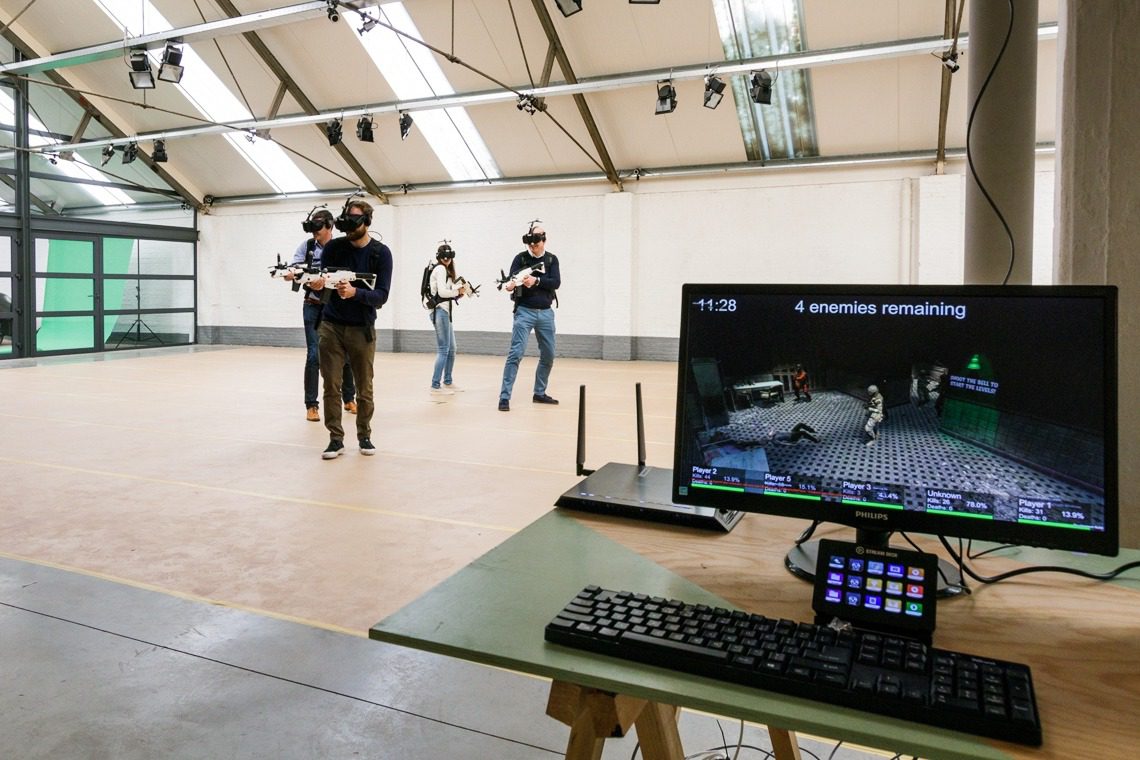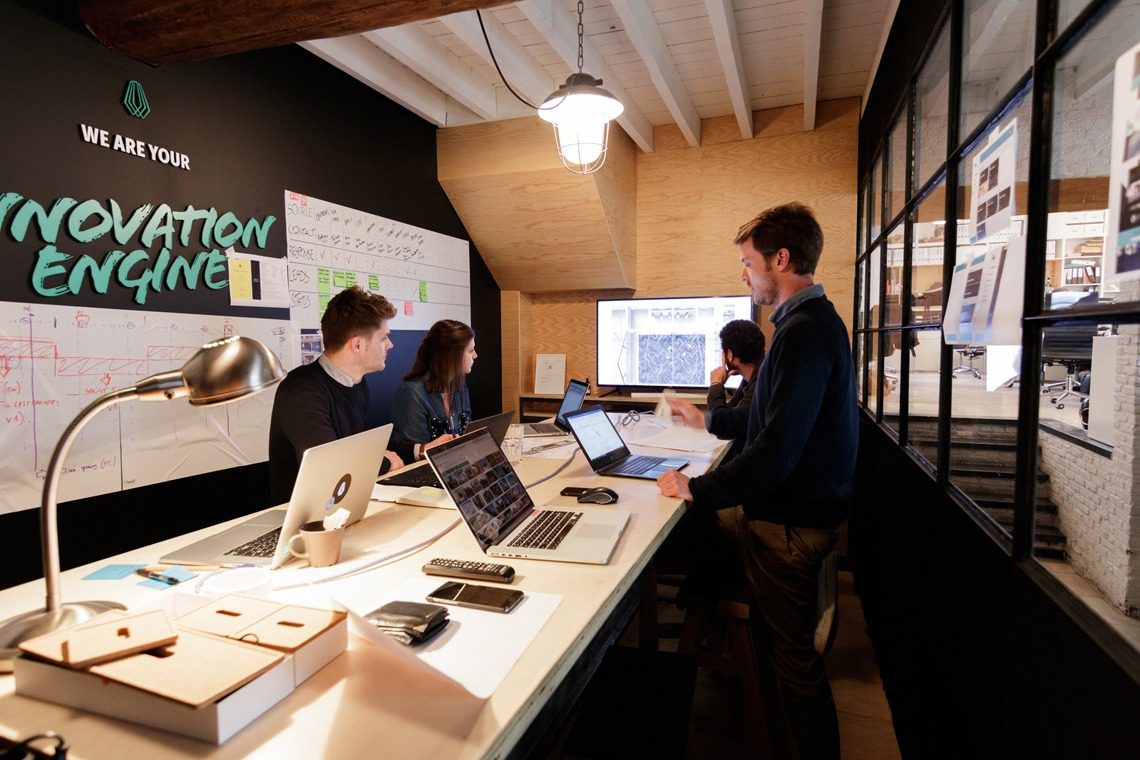Key takeaways
About 2 months ago, we launched The Park, a corporate startup in entertainment with Telenet and 9.5.
We were so proud, and maybe we are even more now that we see how successful it already is.
After a year of hard work, there’s no better feeling than customers coming in every day and being swept off their feet when they come out of this brand new immersive reality experience.
Wait, maybe I’m moving too fast. Let’s take a step back.
What’s The Park Playground? Well, The Park drops you smack-bang into a thrilling virtual world where action-packed adventures await. It’s a location-based virtual reality experience—you can move freely through an immersive world where everyday rules don’t apply, but an unforgettable experience is guaranteed. It’s reality, but not quite as you know it. If you could travel anywhere, where would you go? In The Park, that question isn’t hypothetical. You walk onto a lifelike stage set, where you and your teammates play the leading roles. The level of detail exceeds your imagination. It’s truly unreal!
Curious for more? Definitely visit the website to get more info about this brand new startup and how you can get tickets to experience it for yourself.
We already explained how we launched The Park in a year. But what I would like to share with you in this article is less about what it is, or how we launched it, but more about what we’ve learned from this.
1. Don’t fall for the “why can’t we do both?” trap. Focus!
This might be the biggest pitfall of every startup, and especially in a corporate startup. The moment where you need to choose a focus before you launch your MVP on the market. This skinning down of your concept is crucial, but so scary! It’s damn frightening to take a leap of faith (even if it’s based on validation) for these couple of launching features, and leave all your other ideas out, or stored in a drawer for later. Suddenly, the “big concept” feels so naked, fragile, and too niche to enter the market. We’ve seen our clients go wild over us forcing them to focus, and it’s still a hard moment for ourselves too, to be honest. But that’s exactly where you are on a roll, trust me!
Let me take you through one specific dilemma we’ve encountered in The Park that explains this well.

We started with the challenge “what can the Future of Entertainment be,” and we tackled this question with our usual design sprint methodology. About 10 concepts arose, and then 3 were withheld and validated with users. After a quick iteration, we decided to continue on the general strategy of “phygital entertainment,” where physical and digital activities, such as paintball and shooting computer games, meet in one new immersive format.
Dilemma: we could pursue in the immersive location-based VR direction (in which we finally launched) or we could become a new host of digitally enhanced sports (think playing basketball/football/… on a digitally enhanced field). Both are phygital entertainment, but each has a very different business model, core competency, rollout, target group, … Tough decision to make, since there was a huge potential in both directions. The client’s first reaction was “Why can’t we do both?” Really? No! And there it is, exactly that moment when you have to focus. Left or right? What do you do? Well, you look back at your validation results and you make a decision based on that and on your corporate strategy.
In this case, the location-based VR could leverage the Telenet assets (content, partnerships, …) a lot more, so we killed the digitally enhanced sports track. It’s terrifying and painful at first, but what a great feeling afterward, to have that clear proposition towards your customer!
2. Speed and cost are key, hack the process where you can
We have our methodology to build startups. We have the tools. We have the whole shebang. It’s our backbone to speed things up. But every new startup is still a startup, where the rules of speed and cost overrule every methodology now and then. So shortcut every single process you can…
Let me give you some concrete examples from The Park, to make this a bit more tangible.
First one: When we had our concept validated with customers and with the Telenet board, it was time to build an MVP. But then, we found out that there were already some very few startups out there we could learn from, so we changed that strategy. Instead of building an MVP, we saved that initial cost, we saved ourselves time, and we got very useful insights and potential partnerships out of these startups. We took a shortcut, so we could move in no time from concept to startup launch.
Another key moment in this case was when we had to develop our first game. Instead of building this from scratch, or hiring an internal team, we jumped on a partnership to co-develop it. Again, months of development and costs saved.

Where did we fail to hack and lost speed in this startup? We thought that finding a location for our venue was a piece of cake. Just go on a rental marketplace online and you’re off, is what we thought. But we couldn’t have been more wrong. We didn’t think of the permit that was needed for this type of venue, which turned out to be a huge road bump in our search. It cost us an extra month before we could kick off the interior design work. And we could have easily hacked this by immediately involving the right real estate experts.
Last quick tip here: We came up with our first startup name (BEYOND) and logo in about 2 hours. Don’t waste too much time on branding if your concept is not proven yet.

So remember, the real lean startup thinking mindset in the team is more crucial than any methodology or tool out there! And definitely in a corporate environment, people dare to forget this thinking, and grasp too easily at the more secure, full stack processes.
3. Design sprints work, but use and tweak them wisely in your process
Design sprints. Hackathons. Workshops. In every innovation environment, these terms pop up as the solution to all of your problems. Every now and then, we get to do a hackathon/sprint for a corporation. We have a pretty clear opinion about this: sprints are not the solution in and of themselves. You don’t solve your complete innovation needs in one week (I hope I didn’t crush your dreams here). But they are amazing tools to speed things up, to shortcut certain trajectories in your startup process. Particularly in the ideation or MVP phases, to get people together and to build tangible things fast.
We ran about 60 design sprints in the last 2 years, where we tweaked our methodologies continuously to run them even better in the future. And we also learned a thing or two in this corporate startup with Telenet that I’d like to share with you.
First of all, people (and us too, hands down) like to think of a one week format for a sprint. It makes things very tangible and looks solid. But in reality, we felt that in the sprints with Telenet, full-week sprints were just too intense. Both from a people capacity and from a decision-making perspective. Making a group of people available for that much time is butchering agendas, and you feel that you are pushing your client to rush through too many strategic decisions at the same time. The solution? I recommend you work with 2-3 days sprints, with a couple of breaks in between. This gives the group the time to validate with other internal people, with external people, and with themselves. Even when not actively working on it, thinking about the decisions to be made while in the shower or while talking to a colleague over coffee can work miracles.
Second thought about the sprints is that they change face, depending on where you are in the process. And sometimes, they cannot be even applied at all.
I’m still a big fan of using this format for concept generation, where you focus first on quantity of ideas/concepts with a bunch of people, to then validate with the core team. But in MVP development these sprints look completely different, where just a handful of people focus on design and building product interfaces, for example.
So if you have ever run a hackathon or design sprint, think twice. Challenge yourself on what you are going to use it for, where it fits in the bigger picture of your project, who you’ll involve, and don’t forget the break days.
4. The importance of establishing the new legal entity of the startup on time
We moved as a separate speedboat from the Telenet Tanker from the very start. Startup team, separate brand, freedom to operate, budget allocation, … Even our own startup room outside of Telenet to secure the focus of the team. And we all knew that, at a certain moment, we’d have to also set up the legal entity. But we realized too late what impact this would have on the launch of the startup.
In our second internal fundraising, we got the necessary budget to cover CAPEX and OPEX to launch our first venue in 2018 and to grow further in 2019. We used this budget to start launching the startup immediately. we started interviewing people to hire, we had a lot of day-to-day operational expenses, and we started the development of the online payment system to book tickets. And then it suddenly hit us. How were we going to hire these people in the startup? Which credit card were we going to use to pay for the online subscriptions and day-to-day expenses? And, most of all, which company and account would be connected to the payment system when people booked online?
Yes … we should have started the establishment way earlier. It takes quite a while to set it up, get your bank accounts, get your bookkeeper, … Finally this cost us a month of delay in a lot of operational matters. We didn’t even know until the very last day before the launch whether we would have the new bank account ready behind the payment system or not.
Lesson definitely learned! Make it a priority to establish the legal entity of your corporate startup on time, or you might end up with hiccups in hiring, payments, operational expenses, legal contracts, and more.

5. It’s all about people: scout the right people, give them time to focus and the freedom to operate, don’t overstaff, and hire on time!
It’s that one ingredient in every startup that’s so hard to grasp, but the oh so crucial one. There’s the idea, the USP, the business case, the roll out planning, … But one thing I see over and over again, is that people tend to forget about the team that is actually going to do it. It’s not a myth that many investors out there pick the people above the idea, because they know that with the right people the idea will eventually pivot in the right and successful direction.
5 things are very important here:
- Take the time to look for the right people
- Give those people full-time focus
- Don’t overstaff your team
- Give these people the freedom to operate with the startup speed I mentioned before
- Hire new people on time!
A scenario where I have seen this going terribly wrong (and where basically I think you’re always doomed):
You start a project with 20 people involved with 20% of their time. Over time, you change the project-lead 4 times, the core decision makers of the company are only brought onboard 2 months into the project, … Result? No real involvement, too many superficial opinions involved, focus changes continuously ending up in an all-in-one concept that makes everybody happy in the corporate but not any customers on the market. The typical concept that never gets further than a slick 80 slide deck PowerPoint presentation.
What worked successfully in The Park?
A core team of 3 people that spent full-time focus on the startup, surrounded with 2 people that were at least 50% involved, and an expert team that could be plugged in when necessary. (About 10 people, from within Telenet and external). The focus of the core team was aligned and effective: a general lead, a product lead, and a marketing lead. They were there from the start, and they went all the way to launch. That’s all you need: nothing more, nothing less.

What went wrong?
Bundl builds startups all the way from the ground up to launching on the market. And one of the final steps is to hire the startup team that will replace our position in the venture. In this case, we only started interviews when we already needed the CEO to be there. Take into account that you need at least 2 months to find your CEO (interviews + selection + contracting). So start hunting for your startup team early enough, making the transition as smooth as possible, before the launch of the startup. Of course it all worked out in the end for us, but I’m pretty sure we could have saved ourselves some stress there.
6. If you build a corporate startup, use the corporate assets
We mentioned this in one of our articles before, but once again, in this case, I’ve seen the power of corporate assets for a startup and how to use them.
Telenet is a Telco company with marketing channels, partnerships, resources, funding possibilities, a proven brand, and a huge amount of customers. And what a head start we had by leveraging that!
First of all, the corporate strategy team has been, and still is, a great input along the whole ride. Having an advisory board so easily accessible makes a big difference in making key decisions. And not only in strategy, but we have been able to rely on people from legal, marketing, IT, …
And I don’t think I have to mention how useful the marketing channels have been. That might have been one of the biggest quick wins, in this case. We not only had access to an array of online marketing channels, but also to press partnerships and others.
Our third corporate asset hack were the 3 internal funding rounds. We’ve been involved in a series of non-corporate startups, and if you’ve been there, you know how long it takes to find and close investor rounds. In some startups that’s quite a continuous cycle. The funding possibilities of Telenet itself were therefore priceless.

These are just some examples of how we have embraced the corporation as one of the biggest assets of a startup, while building The Park from scratch. So make sure you’re looking out for hacks in your corporate startup too!
Good luck in your (ad)venture!
And stay tuned to hear more of our insights!
Want to know more about corporate startups?








